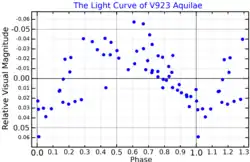 A photoelectric (yellow) light curve for V923 Aquilae, plotted from data presented by Lynds (1960).[1] The length of a full phase cycle is 0.8518 days. | |
| Observation data Epoch J2000 Equinox J2000 | |
|---|---|
| Constellation | Aquila |
| Right ascension | 19h 30m 33.12199s[2] |
| Declination | +03° 26′ 39.8583″[2] |
| Apparent magnitude (V) | 6.06[3] 5.98 to 6.18[4] |
| Characteristics | |
| Evolutionary stage | Main sequence[5] |
| Spectral type | B7III[6] |
| U−B color index | −0.31[3] |
| B−V color index | −0.019±0.008[7] |
| Variable type | Be star[4] |
| Astrometry | |
| Radial velocity (Rv) | −26.0±7.4[7] km/s |
| Proper motion (μ) | RA: 11.717[2] mas/yr Dec.: 3.089[2] mas/yr |
| Parallax (π) | 3.6705 ± 0.0607 mas[2] |
| Distance | 890 ± 10 ly (272 ± 5 pc) |
| Absolute magnitude (MV) | −0.87[7] |
| Details[5] | |
| Primary | |
| Mass | 6.2±0.3 M☉ |
| Luminosity | 1517+158 −143 L☉ |
| Surface gravity (log g) | 3.64±0.21 cgs |
| Temperature | 16,580±400 K |
| Rotational velocity (v sin i) | 275±17 km/s |
| Secondary | |
| Mass | ~0.5 M☉ |
| Other designations | |
| Database references | |
| SIMBAD | data |
V923 Aquilae is a variable binary star[9] system in the equatorial constellation of Aquila. It has the designation HD 183656 from the Henry Draper Catalogue; V932 Aql is the variable star designation. The system is dimly visible to the naked eye with an apparent visual magnitude that fluctuates around 6.06.[3] It is located at a distance of approximately 890 light years from the Sun based on parallax,[2] but is drifting closer with a radial velocity of around −26 km/s.[7]
This system was first identified as a likely spectroscopic binary by W. E. Harper in 1937, who noted it showed "narrow intense lines of peculiar spectrum".[10] P. W. Merrill and C. G. Burwell identified it as a shell star in 1949.[11][12] Merrill and A. L. Lowen showed in 1953 that the shell displayed large radial velocity variations.[13] A photometric study by C. R. Lynds in 1960 showed the system varied in brightness with an amplitude of more than 0.1 in magnitude and a characteristic period of 0.85 days, although it does not behave periodically over long time intervals.[1]
A more thorough investigation by P. Koubský and associates in 1989 using long-term radial velocity measurements determined this is a spectroscopic binary with an orbital period of 214.75 days. There is also an overlaying long-term cyclical variation of changing amplitude and period. The modelled binary system shows a primary with a class of around B5–7e and a low mass secondary separated by around 250 times the radius of the Sun (250 R☉). They hypothesized that the long-term variation was due to an envelope created by a mass transfer from the secondary component to the primary.[14] However, the mass transfer concept was later brought into question and remains unverified as of 2004.[9]
References
- 1 2 Lynds, C. R. (March 1960), "The Light-Variations of HD 183656", Astrophysical Journal, 131: 390, Bibcode:1960ApJ...131..390L, doi:10.1086/146842.
- 1 2 3 4 5 6 Brown, A. G. A.; et al. (Gaia collaboration) (August 2018). "Gaia Data Release 2: Summary of the contents and survey properties". Astronomy & Astrophysics. 616. A1. arXiv:1804.09365. Bibcode:2018A&A...616A...1G. doi:10.1051/0004-6361/201833051. Gaia DR2 record for this source at VizieR.
- 1 2 3 Haupt, H. F.; Schroll, A. (1974), "Photoelektrische Photometrie von Shell-Sternen", Astronomy and Astrophysics Supplement Series, 15: 311, Bibcode:1974A&AS...15..311H.
- 1 2 Samus', N. N; et al. (2017). "General catalogue of variable stars". Astronomy Reports. GCVS 5.1. 61 (1): 80. Bibcode:2017ARep...61...80S. doi:10.1134/S1063772917010085. S2CID 125853869.
- 1 2 Zorec, J.; et al. (November 2016), "Critical study of the distribution of rotational velocities of Be stars. I. Deconvolution methods, effects due to gravity darkening, macroturbulence, and binarity", Astronomy & Astrophysics, 595: 26, Bibcode:2016A&A...595A.132Z, doi:10.1051/0004-6361/201628760, hdl:11336/37946.
- ↑ Houk, N.; Swift, C. (1999), "Michigan catalogue of two-dimensional spectral types for the HD Stars", Michigan Spectral Survey, 5, Bibcode:1999MSS...C05....0H.
- 1 2 3 4 Anderson, E.; Francis, Ch. (2012), "XHIP: An extended hipparcos compilation", Astronomy Letters, 38 (5): 331, arXiv:1108.4971, Bibcode:2012AstL...38..331A, doi:10.1134/S1063773712050015, S2CID 119257644.
- ↑ "HD 183656". SIMBAD. Centre de données astronomiques de Strasbourg. Retrieved 2021-02-21.
{{cite web}}: CS1 maint: postscript (link) - 1 2 Arias, M. L.; et al. (April 2004), "The circumstellar environment of the star V923 Aquilae", Astronomy and Astrophysics, 417 (2): 679–688, Bibcode:2004A&A...417..679A, doi:10.1051/0004-6361:20034435, hdl:11336/37035.
- ↑ Harper, W. E. (1937), "The radial velocities of 917 stars", Publications of the Dominion Astrophysical Observatory Victoria, 7: 1–97, Bibcode:1937PDAO....7....1H.
- ↑ Merrill, Paul W.; Burwell, Cora G. (November 1949), "Second Supplement to the Mount Wilson Catalogue and Bibliography of Stars of Classes B and a whose Spectra have Bright Hydrogen Lines", Astrophysical Journal, 110: 387, Bibcode:1949ApJ...110..387M, doi:10.1086/145215.
- ↑ Bidelman, W. P. (April 1950), "The Spectrum of HR 7415", Publications of the Astronomical Society of the Pacific, 62 (364): 48, Bibcode:1950PASP...62...48B, doi:10.1086/126224, S2CID 119744604.
- ↑ Merrill, Paul W.; Lowen, A. Louise (July 1953), "Intercomparison of Shell Spectra", Astrophysical Journal, 118: 18, Bibcode:1953ApJ...118...18M, doi:10.1086/145723.
- ↑ Koubský, P.; et al. (February 1989), "Properties and Nature of Be Stars. 13. Radial-Velocity Variations of the Shell Star V 923 AQL (HD 183 656) In the Past Sixty Years", Bulletin of the Astronomical Institute of Czechoslovakia, 40: 31, Bibcode:1989BAICz..40...31K.